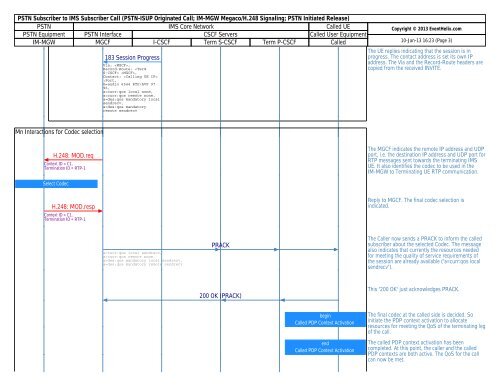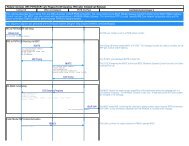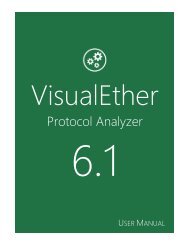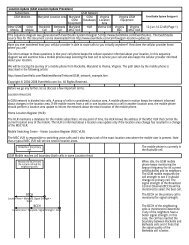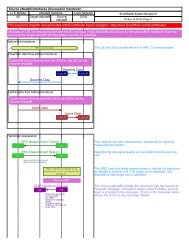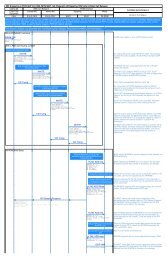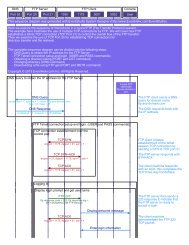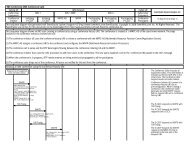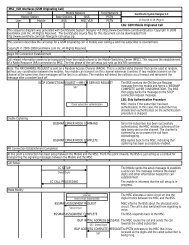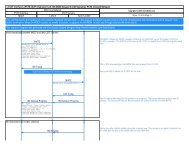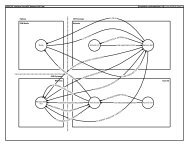PSTN to IMS Call Flow - EventHelix.com
PSTN to IMS Call Flow - EventHelix.com
PSTN to IMS Call Flow - EventHelix.com
You also want an ePaper? Increase the reach of your titles
YUMPU automatically turns print PDFs into web optimized ePapers that Google loves.
<strong>PSTN</strong> Subscriber <strong>to</strong> <strong>IMS</strong> Subscriber <strong>Call</strong> (<strong>PSTN</strong>-ISUP Originated <strong>Call</strong>; IM-MGW Megaco/H.248 Signaling; <strong>PSTN</strong> Initiated Release)<br />
<strong>PSTN</strong> <strong>IMS</strong> Core Network <strong>Call</strong>ed UE<br />
<strong>PSTN</strong> Equipment <strong>PSTN</strong> Interface CSCF Servers <strong>Call</strong>ed User Equipment<br />
IM-MGW MGCF I-CSCF Term S-CSCF Term P-CSCF <strong>Call</strong>ed<br />
183 Session Progress<br />
Via: ,<br />
Record-Route: ,<br />
Contact: <br />
:Port,<br />
m=audio 6544 RTP/AVP 97<br />
96,<br />
a=curr:qos local none,<br />
a=curr:qos remote none,<br />
a=des:qos manda<strong>to</strong>ry local<br />
sendrecv,<br />
a=des:qos manda<strong>to</strong>ry<br />
remote sendrecv<br />
Copyright © 2013 <strong>EventHelix</strong>.<strong>com</strong><br />
10-Jan-13 16:23 (Page 3)<br />
The UE replies indicating that the session is in<br />
progress. The contact address is set its own IP<br />
address. The Via and the Record-Route headers are<br />
copied from the received INVITE.<br />
Mn Interactions for Codec selection<br />
H.248: MOD.req<br />
Context ID = C1,<br />
Termination ID = RTP-1<br />
The MGCF indicates the remote IP address and UDP<br />
port, i.e. the destination IP address and UDP port for<br />
RTP messages sent <strong>to</strong>wards the terminating <strong>IMS</strong><br />
UE. It also identifies the codec <strong>to</strong> be used in the<br />
IM-MGW <strong>to</strong> Terminating UE RTP <strong>com</strong>munication.<br />
Select Codec<br />
H.248: MOD.resp<br />
Context ID = C1,<br />
Termination ID = RTP-1<br />
Reply <strong>to</strong> MGCF. The final codec selection is<br />
indicated.<br />
a=curr:qos local sendrecv,<br />
a=curr:qos remote none,<br />
a=des:qos manda<strong>to</strong>ry local sendrecv,<br />
a=des:qos manda<strong>to</strong>ry remote sendrecv<br />
PRACK<br />
The <strong>Call</strong>er now sends a PRACK <strong>to</strong> inform the called<br />
subscriber about the selected Codec. The message<br />
also indicates that currently the resources needed<br />
for meeting the quality of service requirements of<br />
the session are already available ("a=curr:qos local<br />
sendrecv").<br />
200 OK (PRACK)<br />
This "200 OK" just acknowledges PRACK.<br />
begin<br />
<strong>Call</strong>ed PDP Context Activation<br />
end<br />
<strong>Call</strong>ed PDP Context Activation<br />
The final codec at the called side is decided. So<br />
initiate the PDP context activation <strong>to</strong> allocate<br />
resources for meeting the QoS of the terminating leg<br />
of the call.<br />
The called PDP context activation has been<br />
<strong>com</strong>pleted. At this point, the caller and the called<br />
PDP contexts are both active. The QoS for the call<br />
can now be met.


